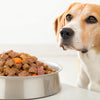Can Wet Food Give My Dog Diarrhea? Understanding the Connection
- Houndsy
Table of Contents
Introduction
As dog owners, we often juggle a multitude of responsibilities alongside our affectionate companions. Feeding our furry friends is not just about meeting their hunger needs; it involves careful consideration of their health and well-being. A staggering statistic reveals that approximately 20% of dog owners report changes in their pet's digestion when switching diets. If you're contemplating introducing wet food into your dog’s meal plan or have already made the switch, questions may arise—can wet food give my dog diarrhea?
In this post, we will delve into the relationship between wet dog food and gastrointestinal issues such as diarrhea. We'll explore the types of wet food available, the benefits and potential drawbacks, and how to safely transition to this new dietary choice. By the end of this article, you should have a comprehensive understanding of how wet food can impact your dog’s digestive health, equipping you to make informed choices that enhance your pet care routine.
Before we dive in, let's take a moment to reflect on our own experiences. Have you ever noticed any changes in your dog after a diet switch, or have you found yourself contemplating which food options best suit your pet's unique dietary needs?
Our main takeaway is that while wet food can be nutritious and appealing, it requires a thoughtful approach to prevent possible digestive disturbances.
Understanding Wet Dog Food
What is Wet Dog Food?
Wet dog food, often available in cans or pouches, is composed primarily of meat mixed with moisture-rich ingredients such as broth or gravy. Its tantalizing aroma and texture can be a delightful change for many dogs, appealing to their natural instincts.
Benefits of Wet Dog Food
-
Increased Moisture Content: Wet food usually contains up to 80% moisture, making it an excellent choice for hydration, especially for dogs that may not drink sufficient water.
-
Enhanced Palatability: The rich flavors and varied textures of wet food are often more appealing to dogs, particularly picky eaters or those with dental issues making chewing harder.
-
Convenient Nutritional Options: Many high-quality wet dog foods are formulated with all necessary nutrients, making them a complete meal option.
-
Easier Digestion: Wet food is often easier for dogs to digest, particularly elderly pets or those with sensitive stomachs. The viscous texture helps to break down food more easily.
-
Excellent for Mixing: Wet food can be a great addition to dry kibble, helping to entice dogs to consume their meals.
Potential Drawbacks of Wet Dog Food
While wet food has many advantages, it’s essential to consider some potential downsides that may relate to digestive health, including:
-
Higher Fat Content: Some wet dog foods can contain more fat than their dry counterparts, leading to digestive issues in some dogs.
-
Less Dental Health Improvement: Unlike dry kibble, wet food doesn’t provide the abrasive action needed to help clean teeth, which can lead to tartar build-up over time.
-
Spoilage Risk: Once opened, wet food can spoil more quickly, especially if left out at room temperature, which could lead to bacterial growth.
-
Transition Issues: If a dog's diet is suddenly changed from dry to wet food without a gradual transition, it can cause digestive upset, including diarrhea.
Can Wet Food Give My Dog Diarrhea?
The short answer is yes, but it’s crucial to explore why. Diarrhea has many causes, and while wet food can be a contributing factor, it is often not the sole reason. Let’s break down some critical components that could be at play.
Food Sensitivities
Each dog is unique, and just like humans, they can be sensitive or even allergic to specific ingredients in their food. Common culprits in wet dog food may include:
- Meat Sources: Some dogs may react poorly to specific protein sources, such as chicken or beef.
- Grains and Fillers: Though many pet foods contain grains like corn or rice, dogs with sensitivities may experience digestive issues.
- Preservatives and Additives: Certain artificial additives or preservatives can lead to gastrointestinal upset in susceptible dogs.
If you’re introducing a new wet food brand, closely monitor your dog for any digestive changes. It may be wise to consult your veterinarian about food sensitivities if diarrhea or other symptoms occur.
Rapid Dietary Transition
Transitioning too quickly from dry food to wet food can overwhelm a dog's digestive system, leading to diarrhea. Experts recommend gradually introducing any new food over 5 to 7 days. Begin by mixing small portions of the new wet food with your dog's current diet, incrementally increasing the new food while decreasing the old.
Overfeeding
Wet dog food can be higher in fat and calories than dry food, leading to overfeeding if portion control is not carefully observed. Overeating can cause gastrointestinal upset, including diarrhea.
Spoilage and Bacterial Growth
When wet food is left out, it can quickly spoil. If a dog consumes spoiled food, it might lead to food poisoning, resulting in symptoms like diarrhea and vomiting. Ensure any opened wet food is stored correctly and consumed promptly.
Tips for Preventing Diarrhea on Wet Food
If you opt for wet food, here are some strategies to help prevent diarrhea:
-
Choose High-Quality Brands: Look for wet food made with whole ingredients and without unnecessary fillers. At Houndsy, we prioritize quality and reliability in all our products, including our signature Houndsy Kibble Dispenser.
-
Transition Gradually: Allow several days for your dog’s digestive system to adjust. A gradual switch can minimize digestive upset and help you track any changes.
-
Monitor Serving Sizes: Be mindful of how much you feed your dog, especially when switching to higher-calorie wet food options. Following package recommendations as a guide might not fit your specific dog's needs, so consulting with your vet can help tailor portions.
-
Store Food Properly: Keep opened wet food refrigerated and use it within 3 days to prevent spoilage. Implementing a Houndsy Kibble Dispenser can help ensure portions are just right—reducing waste and ensuring FDA resistance with an auto-lock mechanism.
-
Stay Alert to Symptoms: Watch for any signs of digestive upset when introducing wet food. If diarrhea persists beyond 24 hours or is accompanied by extreme lethargy, contact your veterinarian.
The Role of Quality in Dog Foods
What Makes a Good Wet Dog Food?
When selecting wet dog food, understanding the ingredients is crucial. Look for the following:
-
High-Quality Proteins: The top ingredient should come from a reliable protein source, such as real meat or fish. Cheaper brands may rely on meat by-products, which are lower quality.
-
Limited Fillers: Avoid brands that prioritize grains or fillers like corn and wheat. These can contribute little nutritional value and may lead to digestive issues.
-
Balanced Nutritional Profile: Ensure the food meets AAFCO (Association of American Feed Control Officials) guidelines, ensuring it provides a complete and balanced diet for your dog.
-
Functional Ingredients: Ingredients like probiotics can help improve digestive health, while antioxidant-rich foods can bolster overall well-being.
Exploring Options for Wet Dog Food
The market today offers a variety of wet dog food options. Here are a few categories to consider:
- Grain-Free: Ideal for dogs with known grain sensitivities, offering alternatives like sweet potato or lentils.
- Limited Ingredient: Great for identifying specific food sensitivities, containing minimal ingredients for easier digestion.
- Homemade: Some owners prefer to prepare their dog’s food at home. While this can ensure quality, it requires careful recipe planning to meet nutritional standards.
When to Consult Your Veterinarian
If you're considering a shift to wet food and have concerns about digestive health, don't hesitate to consult your veterinarian. Signs of digestive distress may include:
- Prolonged diarrhea lasting more than 24 to 48 hours
- Accompanying symptoms like vomiting or lethargy
- Unusual stool characteristics, such as blood or mucus
- Sudden changes in appetite or behavior
Your veterinarian can help discern food-related issues from other health problems and guide you in selecting the most suitable diet for your dog.
Conclusion
Transitioning to wet food can provide numerous benefits for your dog, including enhanced hydration and improved palatability. However, it’s equally vital to perceive the potential risks in digestive health—specifically, the possibility that wet food could lead to diarrhea if not chosen or managed properly.
By implementing strategic choices, monitoring your dog's health, and fostering a gradual transition to wet food, we can enhance our furry companions' lives while minimizing the risk of digestive disturbances. At Houndsy, we remain committed to helping pet owners like you simplify and elevate the feeding experience through quality and functionality—such as with our flagship Houndsy Kibble Dispenser.
If you haven’t explored our innovative feeding solutions yet, now is a perfect time to check them out and see how we can enhance your daily routine. Let’s ensure that both you and your canine can enjoy every meal—and every moment—together.
Frequently Asked Questions
1. Can feeding my dog only wet food lead to diarrhea?
Not necessarily. While some dogs may have sensitivities to certain ingredients in wet food, many dogs thrive on a wet food diet without issue. Always monitor for any changes and consult with a veterinarian if problems arise.
2. How can I help my dog if they have diarrhea after switching to wet food?
Hold off on feeding them for 12 to 24 hours to allow their digestive system to rest. Afterward, reintroduce bland foods in small quantities before resuming their full diet.
3. Is mixing wet food with dry food better for preventing diarrhea?
Many dogs benefit from a mix of wet and dry food, providing diverse texture and flavor—a mix can also improve hydration. Just remember to adjust portion sizes accordingly.
4. What are signs that my dog might be allergic or sensitive to their wet food?
Signs may include persistent diarrhea, vomiting, itching, swelling, or unusual behaviors. If you recognize these symptoms, consult a veterinarian to explore potential allergies.
5. How often should I switch my dog’s diet?
Frequent dietary changes are generally not advisable as they can upset a dog’s stomach. Consult your vet for specific recommendations based on your dog’s age, health, and existing diet preferences.













